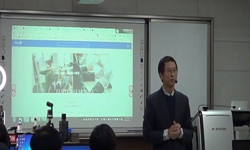In this paper, we reformulated the word formation system and as a result we included some words into the word formation system. Some words, in spite of their morphological change, do not change their syntactic functions and their referential meanings....
http://chineseinput.net/에서 pinyin(병음)방식으로 중국어를 변환할 수 있습니다.
변환된 중국어를 복사하여 사용하시면 됩니다.
- 中文 을 입력하시려면 zhongwen을 입력하시고 space를누르시면됩니다.
- 北京 을 입력하시려면 beijing을 입력하시고 space를 누르시면 됩니다.
https://www.riss.kr/link?id=A82413820
- 저자
- 발행기관
- 학술지명
- 권호사항
-
발행연도
2010
-
작성언어
Korean
-
주제어
조어 ; 조어 과정 ; 지시적 동기 ; 화용적 동기 ; 형식 기제 ; 화자의 태도 ; 정도 평가 ; 명확성 ; 강화 ; word formation ; word formation process ; referential motive ; pragmatic motive ; formal mechanism ; lexicon ; speaker’s manner ; degree estimation ; clearness(certainty) ; intensification.
-
등재정보
KCI등재
-
자료형태
학술저널
-
수록면
37-61(25쪽)
-
KCI 피인용횟수
3
- 제공처
- 소장기관
-
0
상세조회 -
0
다운로드
부가정보
다국어 초록 (Multilingual Abstract)
In this paper, we reformulated the word formation system and as a result we included some words into the word formation system. Some words, in spite of their morphological change, do not change their syntactic functions and their referential meanings. Therefore they are normally treated as the exceptions. However, if we reformulate the word formation system, we can include those words in normal word formation system. Thus we separate “word formation process” into three parts, the word formation motive, formal mechanism, and the lexicon. The word formation motive has two motives: the referential motive and the pragmatic motive. “Pragmatic motive” is represented the speaker’s intention, minute differences of degree of feeling, and clearness or intensification of expressions. Next, the formal mechanism is composed of the compounding, derivation, reduplication, clipping, re-construction of root, and so on. The final part is lexicon, which is the set of outputs and inputs of word formation system at the same time.
목차 (Table of Contents)
- 1. 서론
- 2. 조어의 동인, 기제, 결과의 절차적 분리
- 3. 화용적 동기에 기반한 조어 과정
- 4. 결론
- 참고문헌
- 1. 서론
- 2. 조어의 동인, 기제, 결과의 절차적 분리
- 3. 화용적 동기에 기반한 조어 과정
- 4. 결론
- 참고문헌
- [Abstract]
참고문헌 (Reference)
1 김영석, "현대형태론" 학연사 1992
2 채 완, "한국어의 의성어와 의태어" 서울대학교 출판부 2003
3 박영순, "한국어 화용론" 박이정 2007
4 국립국어연구원, "표준국어대사전" 두산동아 1999
5 북한사회과학원언어연구소, "조선말대사전" 사회과학출판사 1992
6 이현희, "접사의 화용적 기능 설정에 대하여" 형태론 11 (11): 287-311, 2009
7 한글학회, "우리말 큰사전" 어문각 1992
8 고영근, "우리말 문법론" 집문당 2008
9 연세대학교 언어정보개발연구원, "연세 한국어 사전" 두산동아 1998
10 시정곤, "수정판 국어의 단어형성 원리" 한국문화사 1998
1 김영석, "현대형태론" 학연사 1992
2 채 완, "한국어의 의성어와 의태어" 서울대학교 출판부 2003
3 박영순, "한국어 화용론" 박이정 2007
4 국립국어연구원, "표준국어대사전" 두산동아 1999
5 북한사회과학원언어연구소, "조선말대사전" 사회과학출판사 1992
6 이현희, "접사의 화용적 기능 설정에 대하여" 형태론 11 (11): 287-311, 2009
7 한글학회, "우리말 큰사전" 어문각 1992
8 고영근, "우리말 문법론" 집문당 2008
9 연세대학교 언어정보개발연구원, "연세 한국어 사전" 두산동아 1998
10 시정곤, "수정판 국어의 단어형성 원리" 한국문화사 1998
11 신기철, "새우리말큰사전" 삼성출판사 1985
12 김민수, "금성판 국어대사전" 금성출판사 1996
13 송철의, "국어의 파생어형성 연구" 태학사 1992
14 김무림, "국어의 역사" 한국문화사 2004
15 이희승, "국어대사전" 민중서림 1988
16 최형용, "b>임말’과 통사적 결합어" 국어국문학회 135 : 134-220, 2003
17 Aronoff,M, "What is Morphology?" Blackwell Publishing 2005
18 Booij,G, "The Grammar of Words-An Introduction to Morphology, 2nd eds" Oxford University Press 2007
19 Wierzbicka, A, "Semantics-primes and universals" Oxford 1996
20 K.Turner, "Semantics vs. pragmatics, Grammar, Meaning and Pragmatics, Handbook of Pragmatics Highlights 5" Publishing Company 2009
21 Lyons, "Semantics" Penguin 152-178, 1987
22 Dressler,W.U, "Morphopragmatics: Diminutives and Intensifiers in Italian, German, and Other Languages" Mouton de Gruyter 1994
동일학술지(권/호) 다른 논문
-
- 한국어문학회
- 박숙희(Bak Suk-hui)
- 2010
- KCI등재
-
- 한국어문학회
- 정수진(Jeong Su-jin)
- 2010
- KCI등재
-
- 한국어문학회
- 이광호(Lee Kwang-ho)
- 2010
- KCI등재
-
1940년대 이광수의 역사 내러티브와 민족주의 담론의 양상
- 한국어문학회
- 김경미(Kim Kyung-mi)
- 2010
- KCI등재
분석정보
인용정보 인용지수 설명보기
학술지 이력
| 연월일 | 이력구분 | 이력상세 | 등재구분 |
|---|---|---|---|
| 2026 | 평가예정 | 재인증평가 신청대상 (재인증) | |
| 2020-01-01 | 평가 | 등재학술지 유지 (재인증) |  |
| 2017-01-01 | 평가 | 등재학술지 유지 (계속평가) |  |
| 2013-01-01 | 평가 | 등재학술지 유지 (등재유지) |  |
| 2010-01-01 | 평가 | 등재학술지 유지 (등재유지) |  |
| 2008-01-01 | 평가 | 등재학술지 유지 (등재유지) |  |
| 2006-01-01 | 평가 | 등재학술지 유지 (등재유지) |  |
| 2004-01-01 | 평가 | 등재학술지 유지 (등재유지) |  |
| 2001-07-01 | 평가 | 등재학술지 선정 (등재후보2차) |  |
| 1999-01-01 | 평가 | 등재후보학술지 선정 (신규평가) |  |
학술지 인용정보
| 기준연도 | WOS-KCI 통합IF(2년) | KCIF(2년) | KCIF(3년) |
|---|---|---|---|
| 2016 | 0.56 | 0.56 | 0.56 |
| KCIF(4년) | KCIF(5년) | 중심성지수(3년) | 즉시성지수 |
| 0.54 | 0.53 | 0.99 | 0.1 |




 ScienceON
ScienceON DBpia
DBpia







